Grin and bare it: buttock cupping & other health 'cures'
- Published
- comments
If you have ever hankered after living in a bygone age, then the prospect of getting ill prior to the advent of modern medicine should be enough to bring you to your senses.
The Wellcome Library - one of the world's leading collections of medical history - is making freely available more than 100,000 images, from ancient medical manuscripts to works by artists like Goya and Van Gogh.
They include an extensive selection of satirical etchings from the likes of James Gillray and George Cruikshank. These illustrate and poke fun at the misery of ill health, and the medical treatments then in vogue.
Simon Chaplin, head of the Wellcome Library, said: "Together the collection amounts to a dizzying visual record of centuries of human culture, and our attempts to understand our bodies, minds and health through art and observation."
Wellcome has made them available as part of its policy of open access to all.
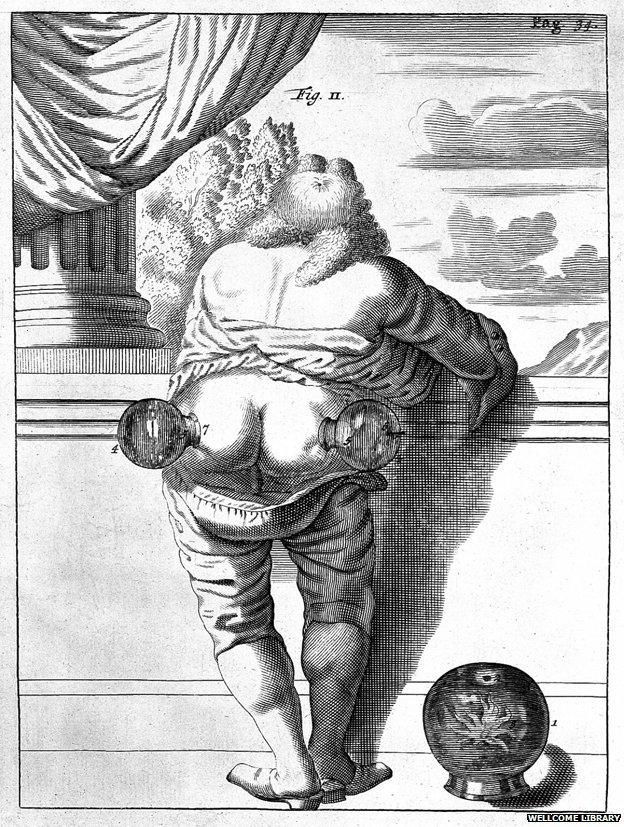
From a medical textbook "Exercitationes practicae" published in 1694 detailing "healing practices, observed and illustrated with pictures of a great number of individuals and their treatment"
This arresting image shows the practice of "cupping" - an ancient therapy where heated cups are placed on the skin. Practitioners claim it helps with a huge variety of ailments from muscle problems to cellulite. In 2004 Gwyneth Paltrow appeared at a film premiere, external revealing the signs of cupping therapy on her back.
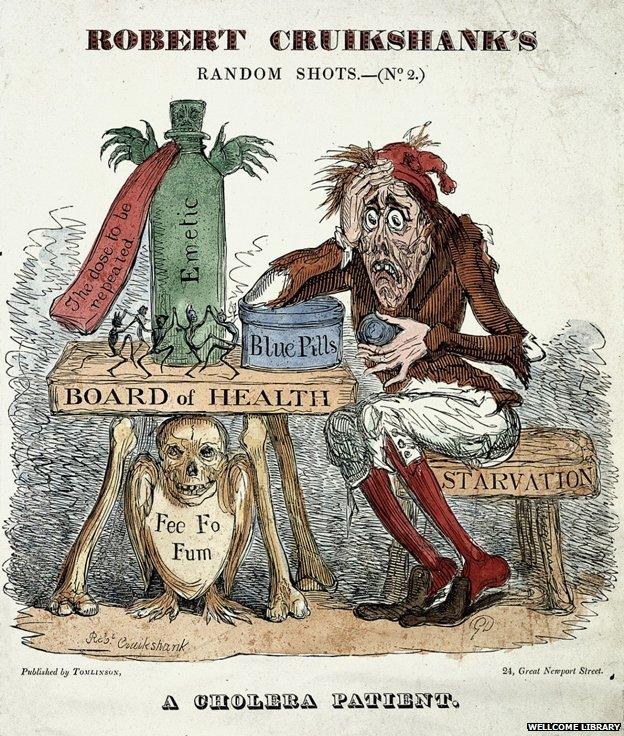
Etching by Robert Cruikshank, showing a cholera patient experimenting with a variety of useless remedies, published 1832
Robert Cruikshank, like his brother George, was an illustrator and caricaturist. There was a cholera pandemic in London that year which killed more than 50,000 people in Britain. The popular belief was it was caused by "bad air". Nearly two decades later, the great public health physician John Snow proved that contaminated water was the culprit.
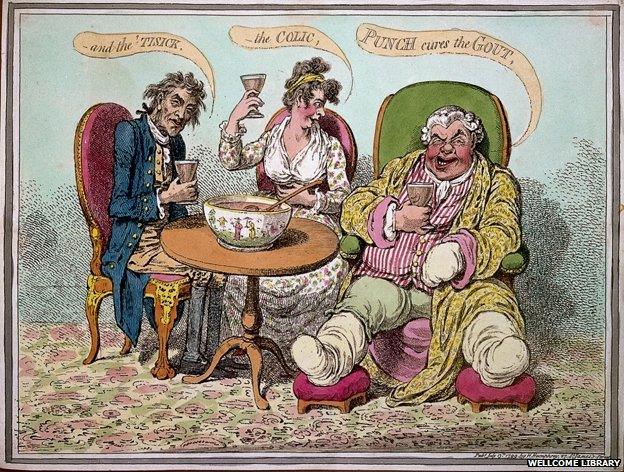
Etching by James Gillray, published 1799, showing an obese gouty man drinking punch with two friends.
The huge increase in cases of gout give this caricature a contemporary relevance. Here the gouty man is drowning his sorrows with punch, together with a woman suffering from with colic (gallstones) and a second man with 'tisick, an archaic word for a cough. The treatment is unlikely to help with any of the ailments.

Etching by George Cruikshank showing a phrenologist in his consulting room. Published in 1826.
The phrenologist has been identified as J De Ville, whose consulting rooms were in the Strand in London. Phrenology was a bizarre but popular pseudoscience based on measurements of the skull.
A scroll on the table says "Thurtell shown to be craniologically an excellent character. Readers at the time would have got the joke: John Thurtell was hanged in 1824 for a brutal murder - his body was sent to London for dissection and a waxwork of him exhibited at Madame Tussauds.
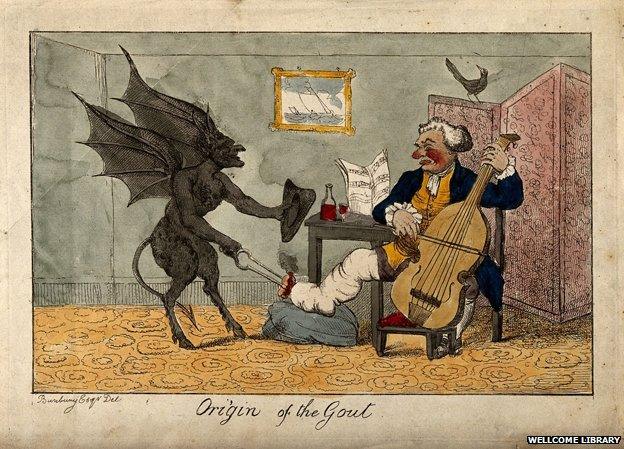
Etching by HW Bunbury of a man with gout, circa 1785
Gout is renowned as being one of the most painful medical conditions. Here a devil is getting to work on a retired naval officer's foot, which is swollen and heavily bandaged. But his red nose and the wine on the table suggest a more prosaic cause of his condition.

Etching by George Cruikshank from a sketch by the late James Gillray, published 1822
Let's face it, none of the characters here looks a picture of health. This etching shows a man about to sneeze after taking snuff. The full title is "A cure for drowsiness, or, a pinch of cephalic". The caption may refer to snuff as a brain stimulant - cephalic means related to the head.

Etching by George Cruikshank, published 1819
Pity this poor woman suffering the pain of colic, or gallstones, illustrated by demons tugging on a rope round her stomach. NHS Choices , externaldescribes the symptoms of gallstones as "sudden, severe abdominal pain that usually lasts one to five hours". These days patients can benefit from painkillers or keyhole surgery to remove the gallbladder.
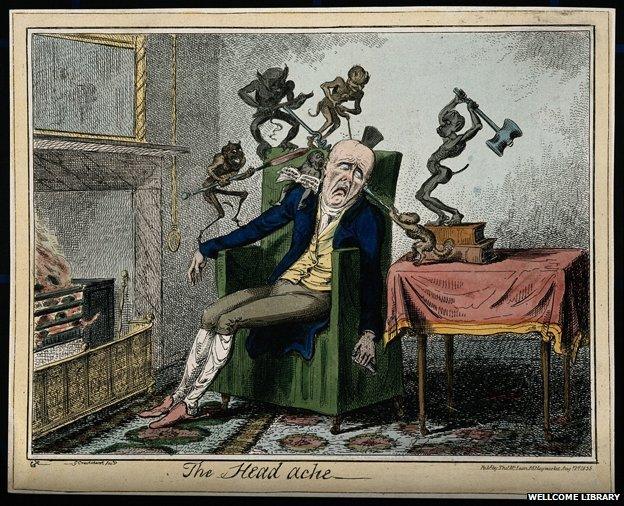
Etching by George Cruikshank published 1835.
Ever had a headache like this? This is a companion piece to the woman suffering from colic. Think of it next time you reach for ibuprofen or paracetamol.
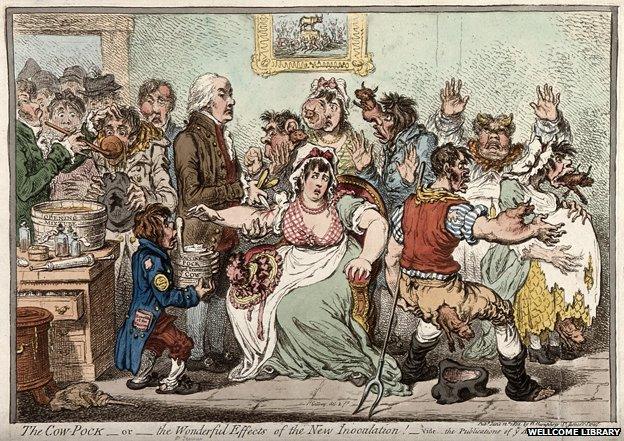
Etching by James Gillray showing Edward Jenner inoculating patients against smallpox, published 1802
This wonderful caricature shows Edward Jenner at work in a hospital at St Pancras in London. It reflects the initial fear and scepticism of many at the prospect of being inoculated with cowpox in order to protect against the much more serious disease of smallpox. The people being treated are sprouting cow's heads. Jenner had published his research in 1798. The term vaccination derives from the Latin word for cow (vacca). Smallpox was finally eradicated in 1980, one of the greatest achievements of public health.